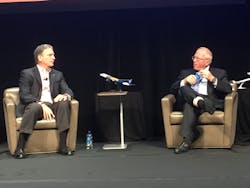Technology and ULCCs Create a New World of Commercial Air Service
Communications technology means travel habits are changing drastically across North America.
Michael Boyd, president of Boyd Group International, said communications technology means short haul air routes are no longer necessary so short routes are disappearing in areas where travelers can opt to drive.
“Short-haul and interregional are both under pressure,” he said. “It doesn’t make sense anymore to fly from Cleveland to Cincinnati. At one time Wright Airlines did it, but it’s not going to happen again.”
Boyd shared his analysis of air travel trends at the International Aviation Forecast Summit Aug. 21, in Denver. More than 300 attendees from airports, airlines and aircraft manufacturers attended the event.
Communications technology means business travelers don’t need to make a lot of short haul trips so they may opt to use virtual meetings or driving instead of flying. Boyd cited examples like Buffalo to Albany as routes disappearing due to changes in traveler preference.
“Do you really want to go to the airport an hour ahead of time and stand in line at Dallas Love Field, fly to Austin and do it again later? I don’t think so,” he said.
The one exception to the rule are flights between the San Francisco Bay area and Los Angeles. Andrew Watterson, executive vice president and chief revenue officer for Southwest Airlines, said routes between those two areas added in recent years have been very successful and expanded.
The world gets smaller
Globalization and new aircraft means midsize airports losing commuter routes are now viable options for international service.
Boyd said the airports he expect to get international air service in the coming years includes Albany International Airport (ALB), Manchester-Boston International Airport (MHT), T.F. Green Airport (PVD), Richmond International Airport (RIC), Norfolk International Airport(ORF), Charleston International Airport (CHS) and Jacksonville International Airport (JAX).
Joe Esposito, senior vice president-network planning, for Delta Air Lines, said international flights from Indianapolis International Airport (IND) and Orlando International Airport (MCO) have been very successful for the airline and show the opportunities available.
“We look at what places like Indianapolis and how they can be successful when they connect in Paris or Amsterdam and because we have such a great connecting complex with our partners in Europe, that’s why those can be so successful,” he said. “We’re looking for more of those opportunities.”
Esposito said Delta continues to enhance its service at hub airports and focus airports, such as Cincinnati/Northern Kentucky International Airport (CVG), Boston Logan International Airport (BOS) and Raleigh-Durham International Airport (RDU).
While Delta has grown flights at RDU, including a new route to Chicago O’Hare International Airport (ORD), Esposito said calls from the Raleigh business community for a direct flight to Asia are not in the cards for now.
“I think that’s going to be a little bit farther down the road,” he said. “For right now, we connect customers over multiple gateways.”
ULCC growth changes the market
Ultra-low cost carriers (ULCC), such as Allegiant Airlines and Frontier Airlines continue to see success in North America. Although many communities that lost air service seek out ULCC’s as an opportunity to find new service, Boyd cautioned you only have about three weeks to make the route work otherwise the airlines will eliminate them.
“There are airports in this room that have seen Frontier come in and six weeks later or six months later they’re mostly gone. They go from nine destinations to three, boom, like that,” he said. “Nothing wrong with the market, it just didn’t have the return that the airline thought would be there.”
He refers to them as “wildcatters,” much like the wildcat oil prospectors of the 1800s who will move one if they don’t make an immediate profit. While their business model may not fit the traditional mold of a North American airline, Boyd said they have proven successful in capturing “discretional travelers,” who would otherwise not fly at all.
“They are changing this marketplace,” Boyd said. “We just heard from Frontier. They’re adding 200 airplanes. That’s just one airline. They’re going to change how things happen and where this happens.”
Bob Fornaro, CEO of Spirit Airlines, said the ULCC is a unique model in the U.S., but has existed elsewhere around the world for some time. Creating a different product allows the airline to compete in the market, much like Southwest and JetBlue have done.
“You don’t be different just to be different,” he said. “You look for a competitive advantage.”
Spirit continues to see growth of about 13 percent while improving its on-time performance rate to about 80 percent during the first seven months of 2018, Fornaro said.
The airline recently announced more routes to the Caribbean and Latin America from MCO and George Bush Intercontinental Airport (IAH). Fornaro said they created those routes on the success of its Fort Lauderdale flights to those markets and the success it has seen. There's some vacation element to the route, but given population centers in Houston and South Florida, there's a major potential for friends and family traffic.
"It doesn't require a different airplane, different rules," he continued "It's really an extension of what we do. It's not complicated."
About the Author
Joe Petrie
Editor & Chief
Joe Petrie is the Editorial Director for the Endeavor Aviation Group.
Joe has spent the past 20 years writing about the most cutting-edge topics related to transportation and policy in a variety of sectors with an emphasis on transportation issues for the past 15 years.
Contact: Joe Petrie
Editor & Chief | Airport Business
+1-920-568-8399
>> To download the AviationPros media kits, visit: Marketing Resource Center
>>Check out our aviation magazines: Ground Support Worldwide | Airport Business | Aircraft Maintenance Technology

